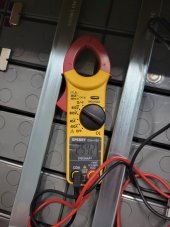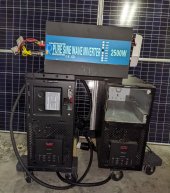TheDan
New Member
- Joined
- Oct 24, 2021
- Messages
- 25
This is completely a result of happen-stance more than anything and I really hope that curiosity DOES NOT kill the cat in this story. As part of my job duties I was tasked with disposing of brand-newish UPS modules that were ordered, forgotten, and then re-discovered only to find out that the install-by date had passed. Instead of paying a recycling service to take this equipment I volunteered to remove it myself so now I am the proud owner of 5 Eaton Blade UPS EBMs. I am sure that you guys will be giving great advice on how to keep that from happening  and aside from "don't do it" I will do my best to heed your warnings.
and aside from "don't do it" I will do my best to heed your warnings.
To give a little back-story, over the past few months I have been installing my solar system (weekend warrior) and taking my time. System consists of:
2 X SolarCity Delta H6 hybrid grid tie inverters (high PV input voltage and high DC battery voltage)
32 X Jinko 405W / 49.7Voc panels / 4 strings and 8 in series
Eaton EBMs consist of:
20 x 12v 9ah lead acid batteries in series giving us a total of 240V per pack and what's more is that each pack has a built in cross connect for daisy chaining packs.
Since starting my solar project I wanted to figure out how to add a battery BUT it seemed unfeasible as the inverters had a proprietary CAN port and there was no way to tell whether it would work on a non-Tesla battery. Why spend thousands on batteries I may not even be able to use, right?
So my first few questions are:
1. Do I need a pre-charge resistor to connect to the inverter for the first time?
2. Is the total watts per pack 2160? (9ah x 240v = 2160W)
3. What gloves would you recommend using when working on this? Gloves seem really stiff and impractical
4. Can I test this without a BMS just to see if the inverter will charge/draw down the batteries at all.
Here are some pictures of what this looks like.
To give a little back-story, over the past few months I have been installing my solar system (weekend warrior) and taking my time. System consists of:
2 X SolarCity Delta H6 hybrid grid tie inverters (high PV input voltage and high DC battery voltage)
32 X Jinko 405W / 49.7Voc panels / 4 strings and 8 in series
Eaton EBMs consist of:
20 x 12v 9ah lead acid batteries in series giving us a total of 240V per pack and what's more is that each pack has a built in cross connect for daisy chaining packs.
Since starting my solar project I wanted to figure out how to add a battery BUT it seemed unfeasible as the inverters had a proprietary CAN port and there was no way to tell whether it would work on a non-Tesla battery. Why spend thousands on batteries I may not even be able to use, right?
So my first few questions are:
1. Do I need a pre-charge resistor to connect to the inverter for the first time?
2. Is the total watts per pack 2160? (9ah x 240v = 2160W)
3. What gloves would you recommend using when working on this? Gloves seem really stiff and impractical
4. Can I test this without a BMS just to see if the inverter will charge/draw down the batteries at all.
Here are some pictures of what this looks like.






